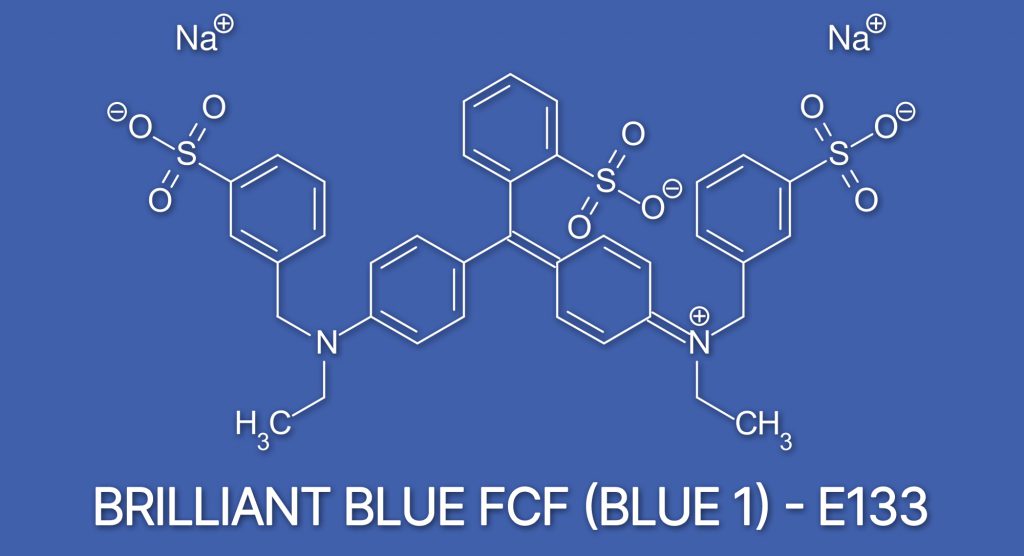Although psychology states that the color blue is among the least appetizing colors, manufacturers put a great deal of effort into putting the color into certain products – especially when the color represents certain flavors such as blueberry, blue raspberry, blue lemonade, and many more. To achieve this color, manufacturers use Blue 1, a synthetic azo dye that gives blue products their distinct color.
As a synthetic dye, Blue 1 is entirely made without the use of any animal products. Thus, Blue 1 can be considered vegan – especially to dietary vegans. However, many vegans find synthetic food color additives problematic because these substances are known to undergo numerous animal testing studies to get the approval of food safety authorities such as the FDA. This means while Blue 1 can be considered dietarily vegan, it cannot be considered ethically vegan.

Blue 1 is a synthetic food color additive that is often used by industries to give their products a blue color. Blue 1 is also known to be used in combination with Tartrazine to make various shades of green.
Blue 1 is also known by other names such as Brilliant Blue, Brilliant Blue FCF, Blue 1 FCF, FD&C Blue 1, Acid Blue 9, E133, and CI 42090.
The synthetic dye is soluble in water with a solubility of 30 mg/L. Under a spectrophotometer, Blue 1 has a maximum absorbance of around 630 nm – the appropriate absorbance for a substance falling under the blue color spectrum (2).
Blue 1 is perfectly suitable for dietary vegans as the food color additive does not contain any animal products.
Despite that description, many vegans tend to avoid synthetic food dyes such as Blue 1.
The most prominent reason why vegans find synthetic food dyes problematic is that these dyes undergo animal testing. Requested and required by food safety authorities, these dyes have to be tested on a wide array of parameters before they can be certified to be used in the industry.
Standing against animal cruelty, ethical vegans extend their lifestyle restrictions beyond food as they also abstain from non-food items that use animal products, as well as products that have been tested on animals.
Another group of vegans that tend to avoid synthetic food dyes is the group that prefers non-processed or minimally processed food. These individuals believe that industrial processing strips away nutritional value from raw ingredients.
Synthetic dyes undergo testing and have to pass several standards before being accepted by food safety authorities.
For example, the FDA reviews a new color additive by assessing factors such as physical, chemical, and biological properties, chemical specifications, manufacturing process, stability data, tolerances and limitations, the proposed regulation, environmental assessments, intended uses and restrictions, analytical methods for enforcing chemical specifications and determination of the color additive in products, and safety studies (1).
The safety of Blue 1 is further validated as it is one of the FDA’s nine certified color additives allowed to be used for food. Other color additives with the same certification include Blue 2, Green 3, Orange B, Red 2, Red 3, Red 40, Yellow 5, and Yellow 6.
This FDA certification allows the usage of these food color additives to food. Moreover, the FDA also determines how much these food coloring agents can be added to certain products.
Another food safety authority that has approved the safety of Blue 1 is the Joint FAO/WHO Expert Committee on Food Additives (JEFCA). JEFCA has evaluated Blue 1 to be safe for consumption through numerous toxicity studies done on various animals (3).
While Blue 1 is generally considered to be safe, caution must be practiced when it comes to this dye and enteral feeding (i.e., feeding an individual using a feeding tube). In 2003, the FDA issued an alert to healthcare providers that reports of toxicity and death have been associated with this dye and enteral feedings (5).
While a synthetic dye, Blue 1 is defined as an organic compound because it is composed of carbon-hydrogen bonds. To synthesize Blue 1, manufacturers oxidize the resulting chemical from the condensation of 2-formylbenzenesulfonic acid and the appropriate aniline (4).
Being one of the oldest synthetic food coloring agents, Blue 1 has been extensively tested on a wide selection of animals.
Officially, Blue 1 has been tested on mice, rats, rabbits, dogs, and cats (3).
While animal testing may have been required in the past for evaluating the safety of certain substances, the practice can be considered unethical in the modern day as safety evaluations can be performed without the use of animal models. Many researchers and industries have begun replacing studies using animal models with in vitro assays/experiments (i.e., the use of cell models instead of animal models) and in silico studies (i.e., the use of computer models and algorithms).
A popular color used in food and other products, Blue 1 is heavily used in a wide array of products such as cotton candy, ice cream, canned vegetables, packet soups, icings, ice pops, blueberry-flavored products, dairy products, sweets, and beverages.
The dye is also used in non-food items such as cosmetics and personal care products (e.g., soaps, shampoos, mouthwashes, etc.).
Synthetic dyes such as Blue 1 are also used in pharmaceuticals as vibrant and distinct colors such as blue help make medications more identifiable.
The easiest way to determine whether a product contains Blue 1 is to check the ingredient lists because micro-ingredients such as food color additives are often required to be included in the label. Furthermore, Blue 1 can also be found in products that are not necessarily color blue because the dye is often mixed with other dyes to make different colors (e.g., mixing Blue 1 with Yellow 5 to make shades of green).
References
